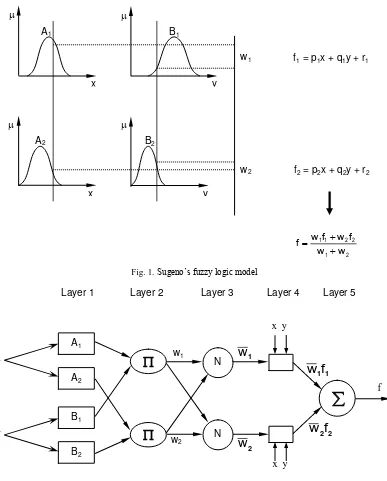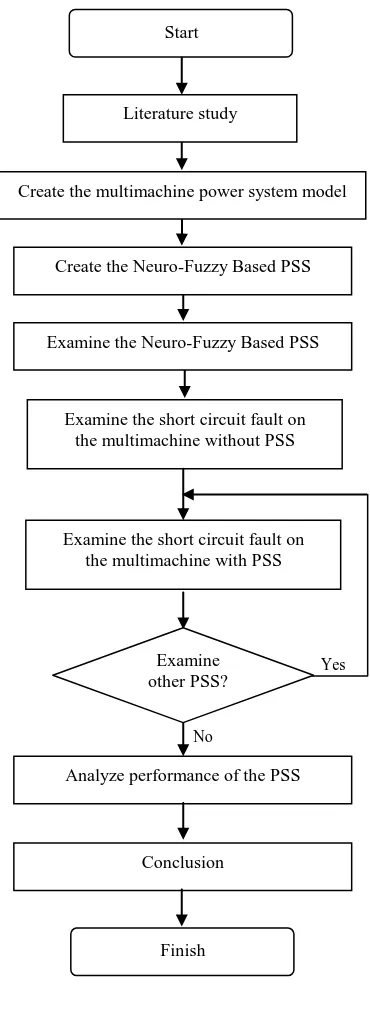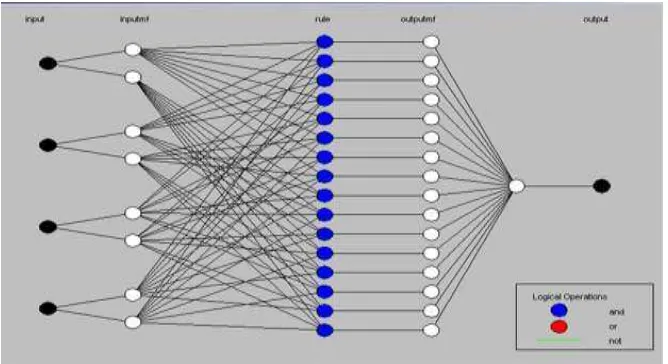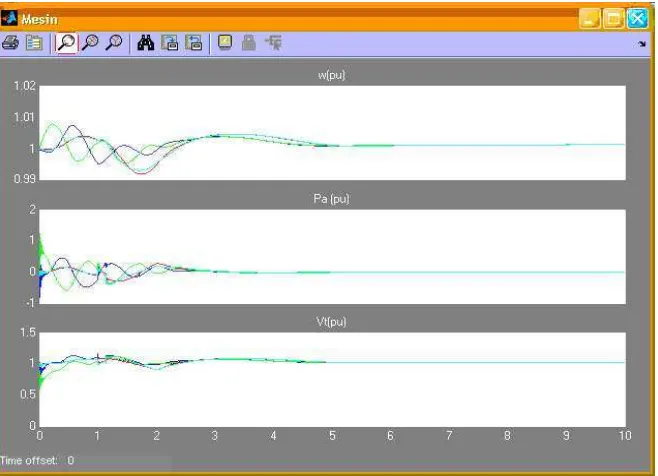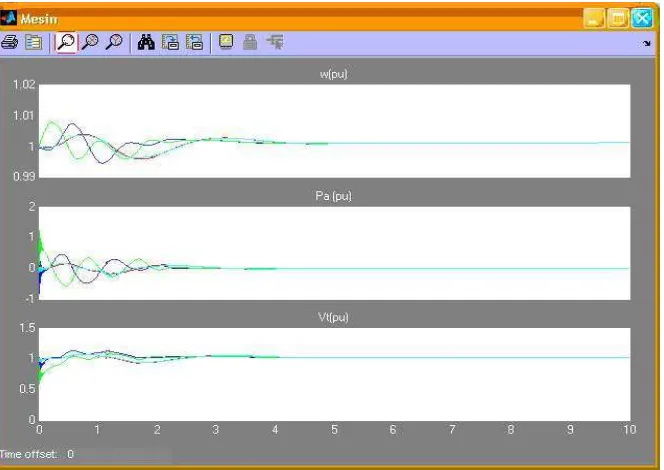Abstract—A contemporary solution to this problem is the addition of power system stabilizers (PSS) to the automatic voltage regulators on the generators in the power system. The damping provided by this additional stabilizer provides the means to reduce the inhibiting effects of the oscillations. The problem is further being complicated by continuous variation in power system operating conditions. In the simultaneous tuning approach, exhaustive computational tools are required to obtain optimum parameter settings for the PSS, while in the case of sequential tuning, although the computational load is fewer, evaluating the tuning sequence is an additional requirement. There is a further problem of eigenvalue drift. This research presents the PSS model based on adaptive neuro-fuzzy for designing robust power system stabilizers for a multi machine system. The system is simulated in Simulink while the PSS is implemented using Fuzzy Logic Toolbox in Matlab.
Index Terms— Power system stabilizer, transient stability, multimachine power system, neuro-fuzzy adaptive.
I. INTRODUCTION
ower system oscillations, especially low frequency electromechanical oscillations have been a major concern in power system planning and operation. On the other hand, increasing operating and maintenance costs as well as continuously increasing demand on electrical energy has forced power companies to call upon all of their installed capacities despite rapidly fluctuating operating conditions. These reasons and the apparition of low frequency local and inter area oscillations hindering power flow have caused renewed interest in robust PSS techniques. Among techniques to enhance power flow, power system stabilizers have been used with field proven efficient for more than 80 years resulting in savings of millions of dollars [1]. PSS have been installed in many countries in the early 60s which witnessed the expansion of system excitation task by using auxiliary stabilizing signals to control the field voltage to damp system oscillations in addition to the terminal voltage error signal. This part of excitation control has been coined as PSS, i.e. power system stabilizer [2]. Early PSS were basically static phase lead compensators inserted ahead of the regulatorexciter to supply supplementary stabilizing signals to compensate for the large phase lag introduced by the excitation system. Yet rapidly fluctuating loading conditions require a more intelligent and more robust approach. Advances in so called intelligent control [3] have thrusted forward their applications in power system control driven by progress in computing technology as well as theoretical
advances methodologies based on hwnan intelligence emulating algorithms such as fuzzy systems, artificial neural networks, genetic algorithms, etc.
New trends were set in PSS leading to a profusion of papers amid which Kothari et al. [4] who developed a variable structure power system stabilizer with desired eigenvalues in the slidiug mode. Hariri and Malik [5] combined fuzzy control with learning propriety of neural network to elaborate a PSS which could lead the equilibriwn state to be trapped into local minima. Hoang and Tomosovic [6] introduced an adaptive fuzzy PSS with 49 fuzzy rules. Abido and Abdel-Magid [7] made use of an evolutionary programming algorithm to calculate the optimal values of a classical lead-lag PSS. Rashidi et al. [8] in which autbors proposed to adapt the gain of the discontinuous component of the control signal used in the sliding mode controller using a fuzzy inference system augmented by linear state feedback applied to a sliding surface with an integral term. Elshafei et al. [9] proposed power system stabilization using fuzzy logic and direct adaptive technique. Hossein-Zadeh and Kalam [10] developed an indirect adaptive indirect fuzzy. Elshafei et al. [11] extended the direct adaptive fuzzy approach to include stabilization of multimachine power systems.
Design of PSS Based on Adaptive
Neuro-Fuzzy Method
AGUS JAMAL AND RAMADONI SYAHPUTRA
Department of Electrical Engineering
Faculty of Engineering, Universitas Muhammadiyah Yogyakarta, Yogyakarta, 55183, Indonesia Email: [email protected]; [email protected]
II. FUNDAMENTAL THEORY
A. Power System Stabilizer
The basic function of a power system stabilizer is to extend stability limits by modulating generator excitation to provide damping to the oscillation of synchronous machine rotors relative to one another. The oscillations of concern typically occur in the frequency range of approximately 0.2 to 3.0 Hz, and insufficient damping of these oscillations may limit ability to transmit power. To provide damping, the stabilizer must produce a component of electrical torque, which is in phase with the speed changes. The implementation details differ, depending upon the stabilizer input signal employed. However, for any input signal, the transfer function of the stabilizer must compensate for the gain and phase of excitation system, the generator and the power system, which collectively determines the transfer function from the stabilizer output to the component of electrical torque which can be modulated via excitation system [12].
Implementation of a power system stabilizer implies adjustment of its frequency characteristic and gain to produce the desired damping of the system oscillations in the frequency range of 0.2 to 3.0 Hz. The transfer function of a generic power system stabilizer may be expressed as ) ( ) 1 )( 1 )( 1 ( ) 1 )( 1 ( ) ( 4 2 3 1 s G sT sT s T sT sT s T K s
GP s f
(1)
where Ks represents stabilizer gain and Gf (s)
represents combined transfer function of torsional filter (if required) and input signal transducer. The stabilizer frequency characteristic is adjusted by varying the time constant Tw, T1, T2, T3 and T4. A torsional filter may not be necessary with signals like power or delta-P-omega signal [13].
A power system stabilizer can be most effectively applied if it is tuned with an understanding of the associated power characteristics and the function to be
performed by the stabilizer. Knowledge of the modes of power system oscillation to which the stabilizer is to provide damping establishes the range of frequencies over which the stabilizer must operate. Simple analytical models, such as that of a single machine infinite bus (SMIB) system, can be useful in determining the frequencies of local mode oscillations during the planning stage of a new plant. It is also desirable to establish the weak power system conditions and associated loading for which stable operation is expected, as the adequacy of the power system stabilizer application will be determined under these performance conditions. Since the limiting gain of the some stabilizers, viz., those having input signal from speed or power, occurs with a strong transmission system, it is necessary to establish the strongest
credible system as the “tuning condition” for these
stabilizers. Experience suggest that designing a stabilizer for satisfactory operation with an external system reactance ranging from 20% to 80% on the unit rating will ensure robust performance [14].
B. Adaptive Neuro-Fuzzy Method
Fig. 1 shows Sugeno’s fuzzy logic model. Fig. 2 shows the architecture of the ANFIS, comprising by input, fuzzification, inference and defuzzification layers. The network can be visualized as consisting of inputs, with N neurons in the input layer and F input membership functions for each input, with F*N neurons in the fuzzification layer. There are FN rules with FN neurons in the inference and defuzzification layers and one neuron in the output layer. For simplicity, it is assumed that the fuzzy inference system under consideration has two inputs x and y and one output z as shown in Fig. 2.
For a zero-order Sugeno fuzzy model, a common rule set with two fuzzy if-then rules is the following:
Fig. 1. Sugeno’s fuzzy logic model
Fig. 2. The architecture of the ANFIS.
Here the output of the ith node in layer n is denoted as On,i:
Layer 1. Every node i in this layer is a square node with a node function:
1 i
O
= Ai(x), for i = 1, 2, (4)or,
1 i
O
= Bi-2(y), for i = 3, 4 (5)Where Ai(x) is chosen to be bell-shaped with maximum equal to 1 and minimum equal to 0, such as the function:
i
i i
A
2b
a
c
x
1
1
(x)
μ
(6)Layer 2. Every node in this layer is a circle node labeled Π .
2 i
O
= wi = Ai(x) x B(y), i = 1, 2. (7) Each node output represents the firing strength of a rule.
A1
A2
B1
B2
x
y
N
N
fx y
x y
2
w
1
w
w1
w2
1 1
f
w
2 2
f
w
Layer 1 Layer 2 Layer 3 Layer 4 Layer 5
A1
A2
B1
B2
x
x
y
y
w1
w2
f1 = p1x + q1y + r1
f2 = p2x + q2y + r2
2 1
2 2 1 1
w w
f w f w f
Layer 3. Every node in this layer is a circle node labeled N.
2 1
i 3
i
w
w
w
w
O
, i = 1, 2. (8)Layer 4. Every node i in this layer is a square node with a node function:
)
i i i i i i 4
i
w
f
w
(p
x
q
y
r
O
(9)Layer 5. The single node in this layer is a circle node labeled Σ .
i i 5i
w
f
O
(10)III. METHODS
The procedure of this research is shown in Fig. 3. The simulation environment based on MATLAB software package is selected. It is used as the main engineering tool for performing modeling and simulation of multimachine power systems, as well as for interfacing the user and appropriate simulation programs. MATLAB has been chosen due to availability of the powerful set of programming tools, signal processing, numerical functions, and convenient user-friendly interface. In this specially developed simulation environment, the evaluation procedures can be easily performed. We have used Fuzzy logic Toolbox of MATLAB to develop the ANFIS model with 4 inputs and single output as given in Fig. 6.
Fig. 3. Procedure of the research.
IV. EXPERIMENTAL RESULTS
A. Adaptive Neuro-Fuzzy PSS
The design process of the Adaptive Neuro-Fuzzy (ANFIS) for PSS go through the following steps: 1. Generation a suitable training data.
In order to use the ANFIS technique for power system stability using PSS, the input parameters limit should
Start
Literature study
Create the multimachine power system model
Create the Neuro-Fuzzy Based PSS
Examine the Neuro-Fuzzy Based PSS
Examine the short circuit fault on the multimachine without PSS
Examine other PSS?
Yes
No
Analyze performance of the PSS
Conclusion
Finish
be determined precisely. The input parameters are obtained from recording devices sparsely located at sending end in a power system network. Due to limited available amount of practical fault data of transmission lines, it is necessary to generate training/testing data using simulation. To generate data for the typical transmission system, a computer program have been designed to generate training data for different faults.
Fig. 5.Membership function of Inputs Variable for PSS
2. Selection of a suitable ANFIS structure for a given application.
Various ANFIS are designed for PSS to extend stability limits by modulating generator excitation to provide damping to the oscillation of synchronous machine rotors relative to one another. Membership function of
inputs variable for PSS is shown in Fig. 5, while the structure of Sugeno type ANFIS for PSS is shown in Fig. 6.
3. Training the ANFIS.
Various network configurations were trained in order to establish an appropriate network with satisfactory
performances. The ANFIS’s are trained to detect
presence of fault, classify fault and finally when the stability system is achieved.
4. Evaluation of the trained ANFIS using test patterns until its performance is satisfactory.
When Network is trained, ANFIS’s should be given an
acceptable output for unseen data. When output of test
pattern and network’s error reached an acceptable
range then, fuzzy system is adjusted in the best situation which means the membership functions and fuzzy rules are well adjusted.
All of these steps above are done off-line and when the structure and parameters of ANFIS are adjusted, it can be used as an on-line the PSS.
In this simulation, multimachine power system is demonstrated under a single line to ground fault simulation and then cleared with opening breaker on line which fault occurred. Disconnecting one of two tie-line transmission lines can change the area power transfer level into single-line power transfer level. System will oscillate to its new stable point, during that time system parameters will deviate. Power transfer from Area1 to Area2, voltage deviation response at M1, and power armature deviation response at M1 are observed and shown in Fig. 7.
Fig. 7.Power transfer from Area1 to Area2.
Fig. 8 shows the performace of Delta w PSS for
angle speed of machine (ω), active power of machine
(Pa), and terminal voltage of machine when single line to ground fault occurs in transmission line. The multimachine power system has achieving the stability state in 5s, although the system has oscillating in 3s. The Delta w PSS need to improve in order to stable the multimachine power system more robust.
The powerful of Neuro-Fuzzy based PSS is shown in Fig. 9. In Fig. 9, the PSS has successfully create the stability of multimachine power system in 3s, although the system has oscillating in 2s. The time for stability is faster than Delta w PSS. Therefore, Neuro-Fuzzy based PSS more robust than Delta w PSS in order to achieve the stability of multimachine power system.
Fig. 8. Performace of Delta w PSS for angle speed of machine (ω), active power of machine (Pa), and terminal voltage of
Fig. 9. Performace of Neuro-Fuzzy based PSS for angle speed of machine (ω), active power of machine (Pa), and terminal
voltage of machine when single line to ground fault occurs in transmission line.
V. CONCLUSIONS
In this study, we present a neuro-fuzzy based power system stabilizer that relies on a fuzzy logic supervisor enabling a soft transition between two robust PSS, Fuzzy and SMC stabilizers to overcome low oscillations inherent to power systems operation. Simulation for two different operating conditions seem to indicate that the approach puts to good use the advantages of the two techniques mentioned while discarding, to some extent, their inherent limitations. Simulation test showed the effectiveness of the robustness of the proposed Neuro-Fuzzy based PSS.
VI. REFERENCES
[1] Berube, G.R., L. Hajagos and R. Beaulieu, 1999. Practical Utility Experience with Application of Power System Stabilizers. IEEE PES Working Group Panel Presentation on Power System Stabilizers.
[2] Kundur. P., 1994. Power System Stability and Control,
McGraw-Hill.
[3] Saadat, H. (1999). Power System Analysis, McGraw-Hill, Singapore.
[4] Abido. M.A. and y.L. Abdel-Magid. 2000. Design of power system stabilizers using evolutionary programming. IEEE Transaction on Energy Conversion, Vol. 17.
[5] Rashidi. F., M. Rashidi and H. Amiri. 2003. An adaptive fuzzy sliding mode control for power system stabilizer. Industrial E1ectroincs Society. IECON. The 29th Ann. Conf. IEEE. 1: 626-630.
[6] E1shafei. AL.. K. E1-Metwal1y andAA Sha1tout. 2005. A variable structure adaptive fuzzy logic stabilizer for single and multi-machine power systems. Control Engineering Practice, Elsevier, 13: 413-423.
[7] E1shafei. AL.. K. E1-Metwal1y andAA Sha1tout. 2005. A variable structure adaptive fzzy logic stabilizer for single and
multi-machine power systems. Control Engineering Practice, Elsevier, 13: 413-423.
[8] Jyothsna, T.R., & Vaisakh, K. (2009). Multi-objective Evolutionary Programming Based Design of PSS, SVC, and TCSC for Transient Stability Improvement, Proceedings of World Academy of Science: Engineering & Technology; 39, 859-863.
[9] Syahputra, R., Soesanti, I. (2016). DFIG Control Scheme of Wind Power Using ANFIS Method in Electrical Power Grid System. International Journal of Applied Engineering Research (IJAER), 11(7), pp. 5256-5262.
[10] Soesanti, I., Syahputra, R. (2016). Batik Production Process Optimization Using Particle Swarm Optimization Method. Journal of Theoretical and Applied Information Technology (JATIT), 86(2), pp. 272-278.
[11] Syahputra, R., Soesanti, I. (2016). Design of Automatic Electric Batik Stove for Batik Industry. Journal of Theoretical and Applied Information Technology (JATIT), 87(1), pp. 167-175.
[12] Syahputra, R. (2016). Application of Neuro-Fuzzy Method for Prediction of Vehicle Fuel Consumption. Journal of Theoretical and Applied Information Technology (JATIT), 86(1), pp. 138-149.
[13] Jamal, A., Suripto, S., Syahputra, R. (2016). Performance Evaluation of Wind Turbine with Doubly-Fed Induction Generator. International Journal of Applied Engineering Research (IJAER), 11(7), pp. 4999-5004.
[14] Syahputra, R., (2016), “Transmisi dan Distribusi Tenaga
Listrik”, LP3M UMY, Yogyakarta, 2016.
[15] Syahputra, R., (2015), “Teknologi dan Aplikasi
Elektromagnetik”, LP3M UMY, Yogyakarta, 2016.
[16] Syahputra, R., Robandi, I., Ashari, M. (2015). Performance Improvement of Radial Distribution Network with Distributed Generation Integration Using Extended Particle Swarm Optimization Algorithm. International Review of Electrical Engineering (IREE), 10(2). pp. 293-304.
[18] Hossein-Zadeh. N. and A Ka1am. 2002. An indirect adaptive fuzzy-logic power system stabilizer, Elsevier. Elec. Power and Energy Sys., 24: 837-842.
[19] Syahputra, R., Robandi, I., Ashari, M. (2015). PSO Based Multi-objective Optimization for Reconfiguration of Radial Distribution Network. International Journal of Applied Engineering Research (IJAER), 10(6), pp. 14573-14586. [20] Syahputra, R. (2015). Simulasi Pengendalian Temperatur
Pada Heat Exchanger Menggunakan Teknik Neuro-Fuzzy Adaptif. Jurnal Teknologi, 8(2), pp. 161-168.
[21] Syahputra, R. (2015). Characteristic Test of Current Transformer Based EMTP Shoftware. Jurnal Teknik Elektro, 1(1), pp. 11-15.
[22] Syahputra, R., (2012), “Distributed Generation: State of the
Arts dalam Penyediaan Energi Listrik”, LP3M UMY,
Yogyakarta, 2012.
[23] Jamal, A., Suripto, S., Syahputra, R. (2015). Multi-Band Power System Stabilizer Model for Power Flow Optimization in Order to Improve Power System Stability. Journal of Theoretical and Applied Information Technology, 80(1), pp. 116-123.
[24] Syahputra, R., Robandi, I., Ashari, M. (2014). Optimization of Distribution Network Configuration with Integration of Distributed Energy Resources Using Extended Fuzzy Multi-objective Method. International Review of Electrical Engineering (IREE), 9(3), pp. 629-639.
[25] Syahputra, R., Robandi, I., Ashari, M. (2014). Performance Analysis of Wind Turbine as a Distributed Generation Unit in Distribution System. International Journal of Computer Science & Information Technology (IJCSIT), Vol. 6, No. 3, pp. 39-56.
[26] Syahputra, R., Robandi, I., Ashari, M., (2014), “Distribution Network Efficiency Improvement Based on Fuzzy
Multi-objective Method”. IPTEK Journal of Proceedings Series.
2014; 1(1): pp. 224-229.
[27] Jamal, A., Syahputra, R. (2014). Power Flow Control of Power Systems Using UPFC Based on Adaptive Neuro Fuzzy. IPTEK Journal of Proceedings Series. 2014; 1(1): pp. 218-223.
[28] Syahputra, R., (2013), “A Neuro-Fuzzy Approach For the Fault Location Estimation of Unsynchronized Two-Terminal
Transmission Lines”, International Journal of Computer
Science & Information Technology (IJCSIT), Vol. 5, No. 1, pp. 23-37.
[29] Jamal, A., Syahputra, R. (2013). UPFC Based on Adaptive Neuro-Fuzzy for Power Flow Control of Multimachine Power Systems. International Journal of Engineering Science Invention (IJESI), 2(10), pp. 05-14.
[30] Syahputra, R., (2012), “Fuzzy Multi-Objective Approach for the Improvement of Distribution Network Efficiency by
Considering DG”, International Journal of Computer Science & Information Technology (IJCSIT), Vol. 4, No. 2, pp. 57-68. [31] Jamal, A., Syahputra, R. (2012), “Adaptive Neuro-Fuzzy
Approach for the Power System Stabilizer Model in
Multi-machine Power System”, International Journal of Electrical &
Computer Sciences (IJECS), Vol. 12, No. 2, 2012.
[32] Jamal, A., Syahputra, R. (2011), “Model Power System Stabilizer Berbasis Neuro-Fuzzy Adaptif”, Semesta Teknika, Vol. 14, No. 2, 2011, pp. 139-149.
[33] Syahputra, R., (2010), “Aplikasi Deteksi Tepi Citra Termografi untuk Pendeteksian Keretakan Permukaan
Material”, Forum Teknik, Vol. 33, 2010.
[34] Syahputra, R., Soesanti, I. (2015). “Control of Synchronous Generator in Wind Power Systems Using Neuro-Fuzzy
Approach”, Proceeding of International Conference on
Vocational Education and Electrical Engineering (ICVEE) 2015, UNESA Surabaya, pp. 187-193.
[35] Syahputra, R., (2015), “Teknologi dan Aplikasi
Elektromagnetik”, LP3M UMY, Yogyakarta, 2016.
[36] Syahputra, R., Robandi, I., Ashari, M. (2014). “Optimal Distribution Network Reconfiguration with Penetration of
Distributed Energy Resources”, Proceeding of 2014 1st
International Conference on Information Technology, Computer, and Electrical Engineering (ICITACEE) 2014, UNDIP Semarang, pp. 388 - 393.
[37] Soedibyo, Ashari, M., Syahputra, R. (2014), Power loss reduction strategy of distribution network with distributed generator integration. 1st International Conference on Information Technology, Computer, and Electrical Engineering (ICITACEE) 2014, UNDIP Semarang, pp. 404 – 408.
[38] Syahputra, R., Robandi, I., Ashari, M., (2013), “Distribution Network Efficiency Improvement Based on Fuzzy
Multi-objective Method”. International Seminar on Applied
Technology, Science and Arts (APTECS). 2013; pp. 224-229. [39] Riyadi, S., Azra, R.A., Syahputra, R., Hariadi, T.K., (2014),
“Deteksi Retak Permukaan Jalan Raya Berbasis Pengolahan Citra dengan Menggunakan Kombinasi Teknik Thresholding,
Median Filter dan Morphological Closing”, Simposium
Nasional Teknologi Terapan (SNTT)2 2014, UMS Surakarta, pp. 46-53.
[40] Syahputra, R., Robandi, I., Ashari, M., (2012),
“Reconfiguration of Distribution Network with DG Using
Fuzzy Multi-objective Method”, International Conference on Innovation, Management and Technology Research (ICIMTR), May 21-22, 2012, Melacca, Malaysia.
[41] Jamal, A., Syahputra, R., (2011), “Design of Power System Stabilizer Based on Adaptive Neuro-Fuzzy Method”. International Seminar on Applied Technology, Science and Arts (APTECS). 2011; pp. 14-21.
[42] Syahputra, R. (2010). Fault Distance Estimation of Two-Terminal Transmission Lines. Proceedings of International Seminar on Applied Technology, Science, and Arts (2nd APTECS), Surabaya, 21-22 Dec. 2010, pp. 419-423. [43] Syahputra, R., (2014), “Estimasi Lokasi Gangguan Hubung
Singkat pada Saluran Transmisi Tenaga Listrik”, Jurnal
Ilmiah Semesta Teknika Vol. 17, No. 2, pp. 106-115, Nov 2014.
[44] Syahputra, R., Robandi, I., Ashari, M., (2011), “Modeling and Simulation of Wind Energy Conversion System in Distributed
Generation Units”. International Seminar on Applied
Technology, Science and Arts (APTECS). 2011; pp. 290-296. [45] Syahputra, R., Robandi, I., Ashari, M., (2011), “Control of
Doubly-Fed Induction Generator in Distributed Generation Units Using Adaptive Neuro-Fuzzy Approach”. International Seminar on Applied Technology, Science and Arts (APTECS). 2011; pp. 493-501.
[46] Jamal, A., Syahputra, R. (2016). Heat Exchanger Control Based on Artificial Intelligence Approach. International Journal of Applied Engineering Research (IJAER), 11(16), pp. 9063-9069.
[47] Syahputra, R., Soesanti, I. (2015). Power System Stabilizer model based on Fuzzy-PSO for improving power system stability. 2015 International Conference on Advanced Mechatronics, Intelligent Manufacture, and Industrial Automation (ICAMIMIA), Surabaya, 15-17 Oct. 2015 pp. 121 - 126.
[48] Mahabuba, A., & Khan, M.A. (2008). Optimal Location of Power System Stabilizers in a Multimachine Power System Using Relative Gain Array (RGA) and Genetic Algorithm (GA). International Journal of Electrical and Power Engineering, 2(1), 19-27.
[50] Syahputra, R., Soesanti, I. (2016). Power System Stabilizer Model Using Artificial Immune System for Power System Controlling. International Journal of Applied Engineering Research (IJAER), 11(18), pp. 9269-9278.
[51] Syahputra, R., Soesanti, I. (2016). Application of Green Energy for Batik Production Process. Journal of Theoretical and Applied Information Technology (JATIT), 91(2), pp. 249-256.
